Pollution, pollen, and pet dander trigger allergies and asthma, while chemical fumes, smog, and smoke particles can do damage even if you don’t have any underlying conditions. Air purifiers remove harmful particles, bacteria, molds, and viruses, so you can safely take a deep breath of fresh air.
If you think you don’t need an air purifier because you don’t have allergies, consider the particles you can smell but can’t see. Smoke, exhaust, and other pollutants make their way into the home just as much as pollen. Whether you have allergies or asthma, those aren’t fine particles you want to breathe in.
The Environmental Protection Agency (EPA) found that air pollutants can be two to five times higher indoors due to poor ventilation. The chemicals and adhesives used in everyday household products can further deteriorate air quality due to fumes from chemicals like formaldehyde and benzene.
There are many types of air purifiers, and they each clean the air in slightly different ways. Some are better at killing bacteria and mold, while others target allergens, dust, and pet hair. You can narrow your search by considering the size of your home, the kind and size of the particles you want to target, and your budget. We’ve included a shopping guide to help you narrow down your choices.
12 Best Air Purifiers of 2024
Best Air Purifier Overall
Coway AP-1512HH White HEPA Air Purifier
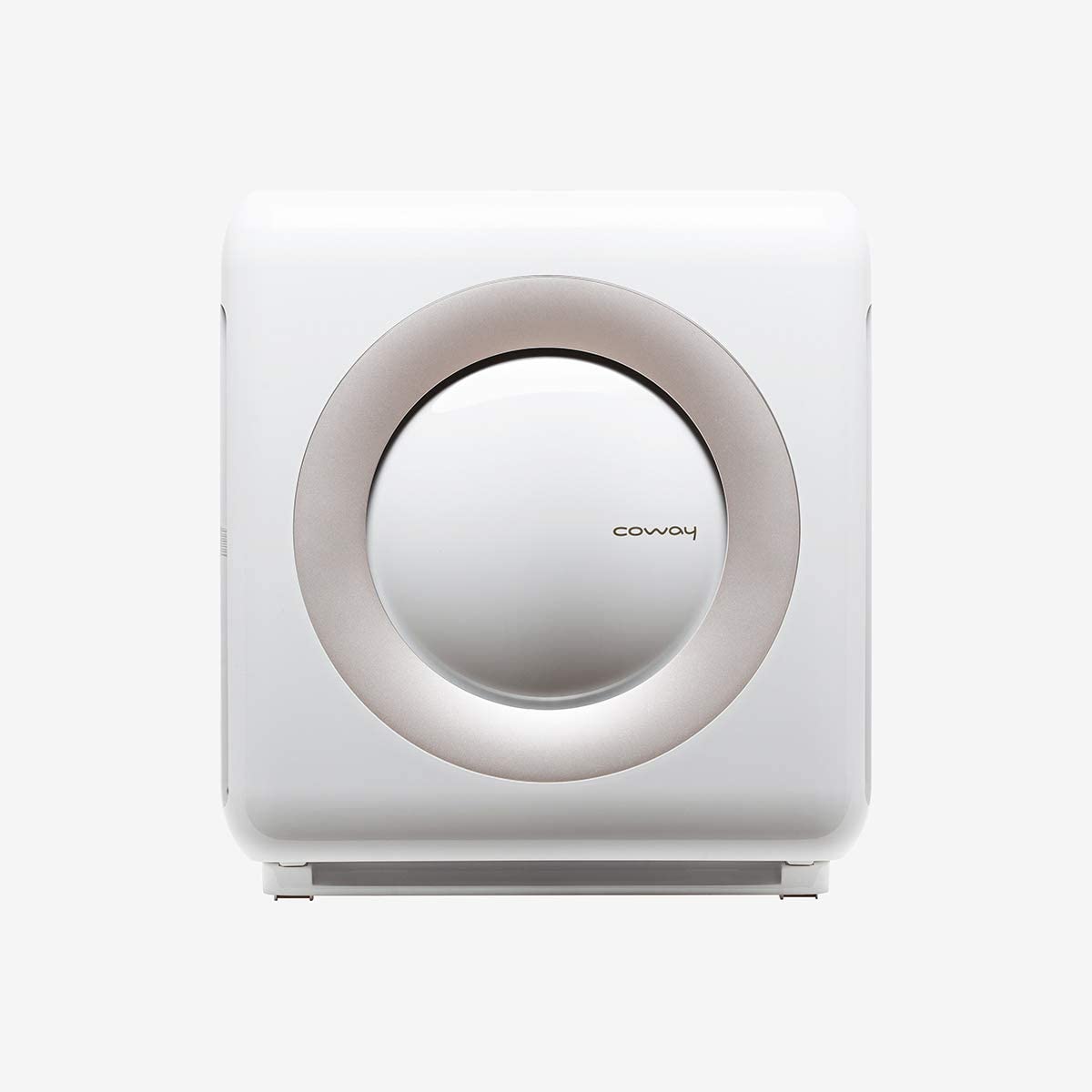
Four-stage filtration, an air quality indicator, and a timer are among the top features of the Coway. Plus, it can clean the air in a space up to 361 cubic feet.
$229.99 from Amazon
Best Air Purifier Overall: Coway AP-1512HH White HEPA Air Purifier
Best Budget Air Purifier: LEVOIT Air Purifier
Best Luxury Air Purifier: Blueair Classic 605
Best Combo Air Purifier: GermGuardian AC4300 Air Purifier
Best HEPA Filter Air Purifier: Alen BreatheSmart Classic Large Room Air Purifier
Best Carbon Filter Air Purifier: Blueair Blue Pure 211+
Best Ionic Air Purifier: AreaMax 300 Large Room Air Purifier
Best UV Air Purifier: SilverOnyx Air Purifier
Best Portable Air Purifier: KOIOS Air Purifier
Best Humidifier/Air Purifier Combo: Sharp Plasmacluster Air Purifier
Best Smart Air Purifier: Dyson Pure Cool Link Tower TP02 Purifier Fan
Best Wearable Air Purifier: Fey-US Wearable Air Purifier

Best Air Purifier Overall
Coway AP-1512HH White HEPA Air Purifier
- Four-stage filtration that targets large and small particles and odors
- Automatic timer to set a 1/4/8/12-hour cleaning schedule
- Filter replacement indicator light
The Coway AP-1512HH White HEPA Air Purifier has the capacity to clean the air in a room up to 361 square feet. For many people, that’s the size of a small family room or good-sized bedroom. Despite this model’s capacity, it’s relatively small, weighing in at only 12 pounds. If you want to move it to another room, it’s not cumbersome to do so.
The real benefit of the Coway comes in the four-stage filtration system. As the air enters the purifier, it’s pulled through a washable pre-filter that removes the larger particles like pet hair and dirt. The air then passes through a carbon odor filter that tackles smoke, pet odors, and food smells.
Next is the True HEPA filter, which removes up to 99.97 percent of mold, pollen, dust, and bacteria. The final level of filtration is the bipolar ionizer, which creates an electrochemical reaction that charges particles and causes them to become heavier and fall out of the normal breathing zone.
The strong filtration system is supported by high-end features like an auto mode that adjusts the fan speed according to air quality. There’s also an air quality indicator light that changes from blue (clean) to purple (polluted) and, finally, red (highly polluted).
You can even manually adjust the fan speed, so the air purifier is always functioning at a level that works for you. If you have company over and want to minimize background noise, you can turn the fan speed down, or if it’s allergy season, you can put it on high. The combination of multiple-stage filtration and a wide range of control features, plus the fact that it performs well, make the Coway our top pick.
“The Coway’s compact design makes it easier to place within a room but doesn’t compromise its ability to filter the air.”
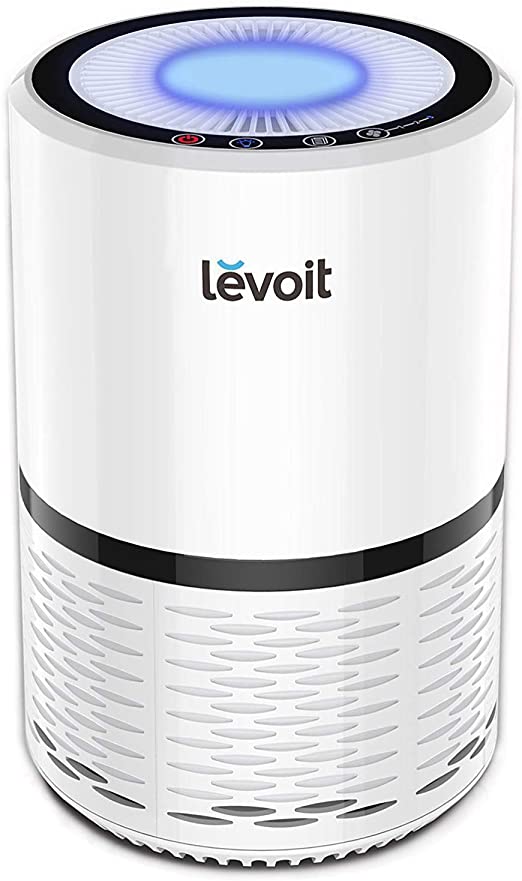
Best Budget Air Purifier
LEVOIT Air Purifier
- Weighs only 8.8 pounds for easy portability
- Functions at 24 decibels on sleep mode
- Choice of four specialized filters — original, pet allergy, toxin absorber, mold and bacteria
The LEVOIT Air Purifier comes with filtration flexibility that larger units don’t usually have. You get to choose one of four filter types — original, pet allergy, toxin absorber, or mold and bacteria. This unit cleans spaces up to 219 square feet, and with those extra filter options, you can target the air pollutants that bother you the most.
Each filter works with a three-stage filtration system. The pre-filter captures large particles like lint and pet hair. A True HEPA filter then removes smaller particles like mold spores, pet dander, and pollen. It’s supported by a third filtration stage with a carbon filter that absorbs odors, smoke, and volatile organic compounds (VOCs).
One of the main benefits of this unit is quiet operation. At 24 decibels, it operates at about the level of rustling leaves, which means you can easily use it in the bedroom. This air cleaner has power lights that make it glow like a nightlight. However, if you really need a dark room for the best sleep, the lights can be turned off. Finally, the LEVOIT is Energy Star Certified, so you’re saving energy and money while you use it.
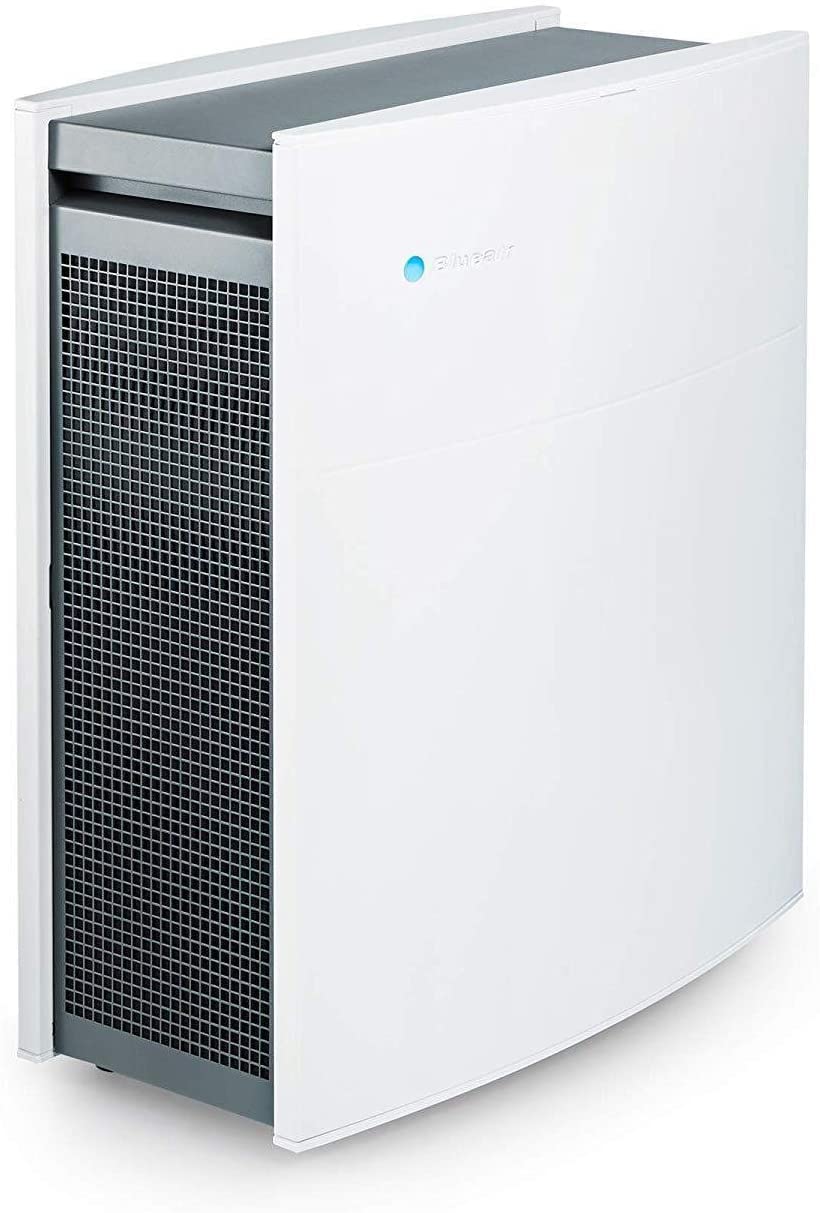
Best Luxury Air Purifier
Blueair Classic 605
- Cleans spaces up to 698 square feet
- Wi-Fi enabled for remote control
- DualProtection filters remove pollen, mold, dust, pet dander, smoke, and viruses
Blueair leads the way in air filtration with this mobile, luxury unit that cleans rooms up to 698 square feet. That’s enough for a living room, kitchen, or large bedroom. It contains Blueair’s HEPASilent technology, which incorporates a dual filtration system to remove troublesome particles and pollutants.
As particles enter the Classic 605, they pass through an electrostatic barrier that charges the particles. A filter then attracts the charged particles, which stick to it like a magnet. Blueair’s filters are designed to capture particles ranging in size from 100 microns (pollen) to viruses as small as .005 microns.
The Classic 605 also connects to an app via Wi-Fi, so you can control the settings from anywhere in the room. You can also use the app to set a timer schedule for your air filtration. This model includes three fan speeds and a filter change indicator. It’s another example of a True HEPA air purifier that provides excellent filtration for indoor air pollution with outstanding ease of use features.
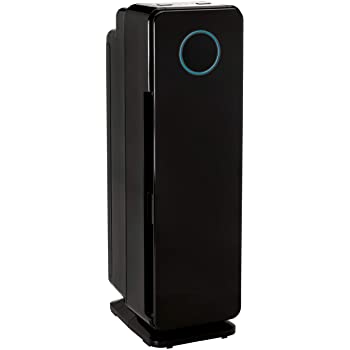
Best Combo Air Purifier
GermGuardian AC4300 Air Purifier
- Filter contains an antimicrobial agent to stop mold and mildew
- Tackles odors with an activated charcoal filter
- Contains an ultra-quiet sleep mode
If germs are one of your top concerns, the GermGuardian Air Purifier is the model for you. It has a traditional HEPA filter to capture everything from large particles like dirt and pet hair to smaller mold spores and bacteria. However, this manufacturer includes a few extras in the filtration system such as UV-C light to capture and neutralize everything in between.
The HEPA filter traps traditional allergens, but it has an added antimicrobial agent that limits growth and odor due to mold, mildew, and bacteria on the filter itself. This model takes filtration another step with UV light technology that incinerates harmful particles as they pass through the purifier. A traditional UV air purifier cannot capture all particles, which is why we like this combo model — what the UV rays can’t kill, the HEPA filter captures.
This model comes with an ultra-quiet sleep mode. Some air purifiers make quite a buzz when they’re running, especially when on their highest speed. But the GermGuardian Air Purifier is designed for use in the bedroom or anywhere else where you don’t want the extra background noise.
Tip: The GermGuardian comes with a 3-year warranty limited warranty that includes access to full tech support.
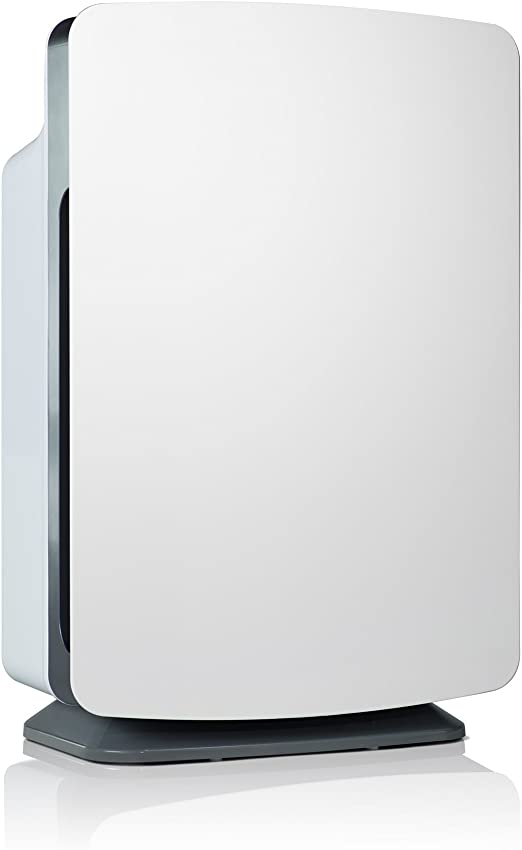
Best HEPA Filter Air Purifier
Alen BreatheSmart Classic Large Room Air Purifier
- 1,100 square foot coverage area
- Nine color options
- Four filter options — HEPA pure, HEPA silver, HEPA fresh plus, HEPA odorcell
This powerful air purifier takes on the largest of rooms with a coverage area of 1,100 square feet. If you’ve got an open floor plan, this is the air purifier for you. It’s also made with an eye for design.
Some air purifiers are less than attractive, and you may have to search for a place to hide it in the room — not with the BreatheSmart. It comes in nine different colors/styles that range from maple and oak to brushed stainless steel and white.
The BreatheSmart’s aesthetics aren’t the only impressive feature. Alen provides four True HEPA filters as options. If you want the most comprehensive air filtration, the HEPA silver is probably the filter for you.
With a four-layer design, it targets mold, bacteria, mildew, and odor. Because it targets the smallest of pollutants, it also filters out the large ones. The HEPA pure has multiple HEPA filter layers to target dust, pollen, dander, and other allergens but not odors.
The HEPA fresh plus focuses on VOCs like fumes from bleach, furniture polish, and adhesives. It’s also a good choice if you live in an area where wildfires and outdoor air pollution are an issue because it traps the tiniest of particles.
Finally, there’s the HEPA odor cell, which contains a conversion powder that neutralizes odors while it captures harmful air particles. No matter the filter you choose, the BreatheSmart gives you ultimate control over your indoor air quality.
The BreatheSmart has ion technology that releases charged molecules that attach to pollutants, making them heavier so they fall out of the breathable zone. It also includes a control to turn this off, in case you just want to filter the air.
Rounding out its list of features is an auto timer and three fan speeds. You can set it to run while you sleep or are away at work. And you always have the ability to adjust the noise levels by lowering the fan speed. If you want a model that will purify the air while blending in with the rest of your home, this is it.
Tip: HEPA filters provide some of the best relief from allergies. There may be times of the year when you need an air purifier on a daily basis, such as during allergy and cold/flu seasons.
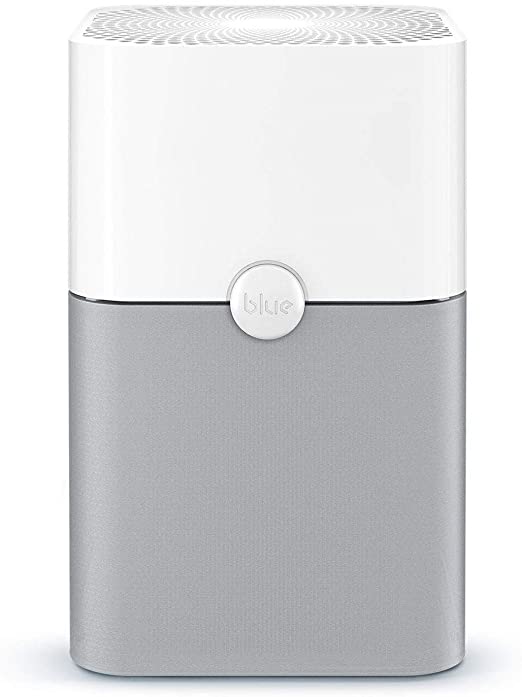
Best Carbon Filter Air Purifier
Blueair Blue Pure 211+
- Weighs 13 pounds but cleans up to 540 square feet
- Uses only 60 watts at the highest fan speed
- A polypropylene filter processes more air at lower fan speeds for less noise
At 13 pounds and five air exchanges per hour, the Blueair Blue Pure 211+ keeps clean air flowing at a remarkable rate. This model pulls in the air from every side, contributing to its ability to maintain clean air in a 540 square foot space. It’s relatively lightweight so you can move it from room to room if necessary.
The 211+ combines particle filtration with a carbon filter that targets odors, chemical fumes, and gases. Like the Classic 605, it contains Blueair’s HEPASilent filtration that captures the dander, pollen, and small particles that aggravate asthma and allergies.
Washable pre-filters remove the largest particles, but with the 211+, they also provide some color options. The 211+ can be used with the pre-filters covered or exposed. Blueair makes them in two colors, so you can change things up once in awhile.
We also like that this model runs on a low 30 to 60 watts. It’s not guzzling the power, yet keeps the air clean and fresh.
Tip: When determining the overall cost of an air purifier, take a look at the price of the replacement filters. Models with washable filters and inexpensive replacement filters will save you money in the long run.
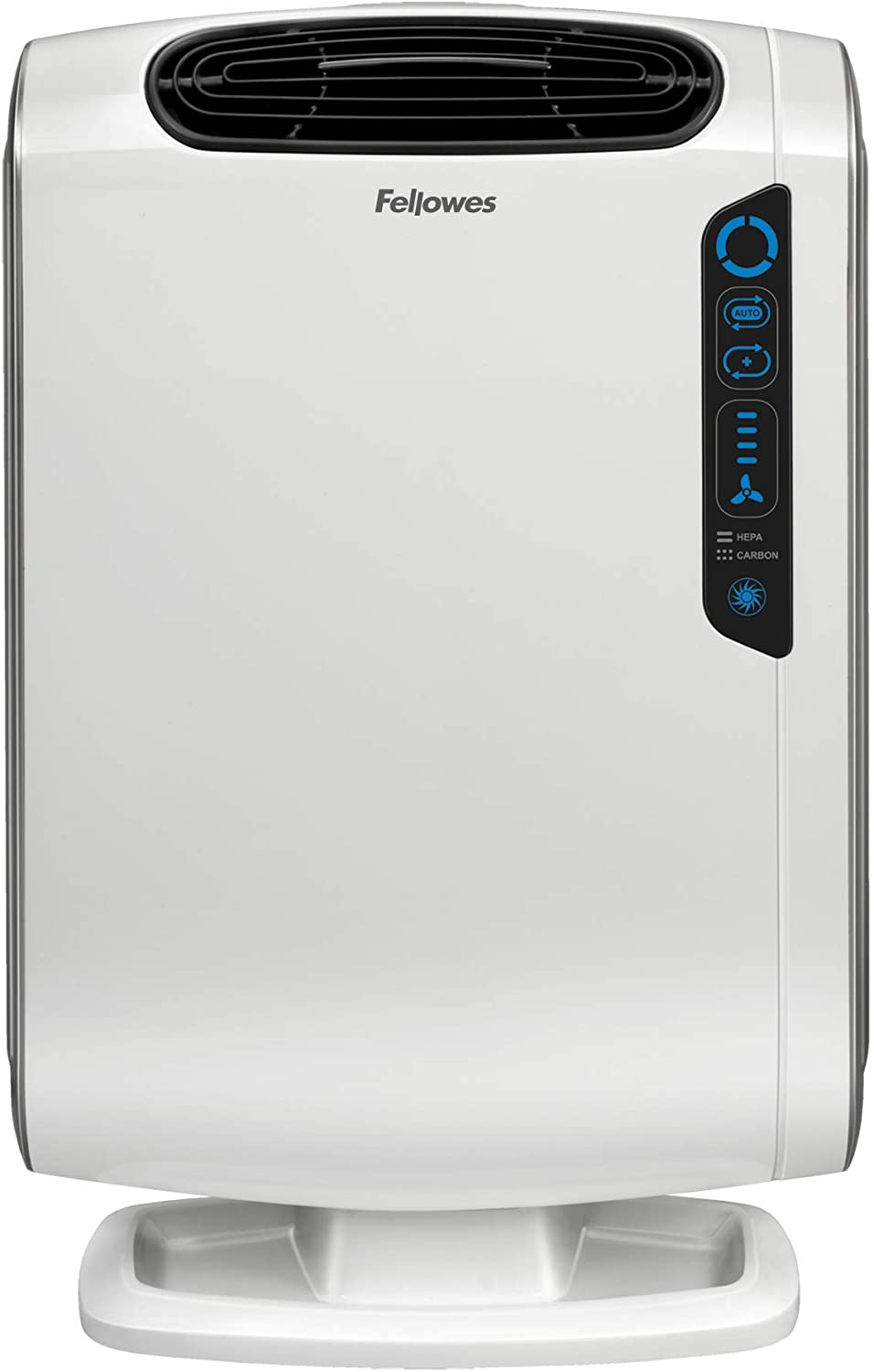
Best Ionic Air Purifier
AreaMax 300 Large Room Air Purifier
- 4-stage filtration system
- Combines the power of carbon and HEPA filters
- Capacity to clean rooms up to 600 square feet
Ionic air purifiers remove harmful organisms like bacteria, viruses, mold, and mildew from the breathable zone. However, they don’t filter out particles unless they’re combined with a carbon and/or HEPA filter, such as in the AeraMax 300.
It starts with a carbon filter capturing particles that cause common household odors like food, smoke, and pets. The air then flows through a HEPA filter, trapping particles as small as .3 microns. During the manufacturing process, the AeraMax 300’s HEPA filter receives an antimicrobial treatment to prevent the buildup of dangerous bacteria, fungi, or mildew.
The filtration’s last stage is what makes this a powerful ionic air purifier — the PlasmaTRUE technology. The PlasmaTRUE technology produces negative ions that attach themselves to positively charged particles. The added weight of the negative ions causes the particles to drop out of the breathing zone and land on other surfaces. They’re less likely to be inhaled on the surface of the floor or couch. However, they will need to be vacuumed, wiped, or swept for complete removal.
Finally, the AeraMax 300 has a high-performance mode that steps up its clean air delivery rate. This feature is designed for use during allergy, cold, and flu seasons.
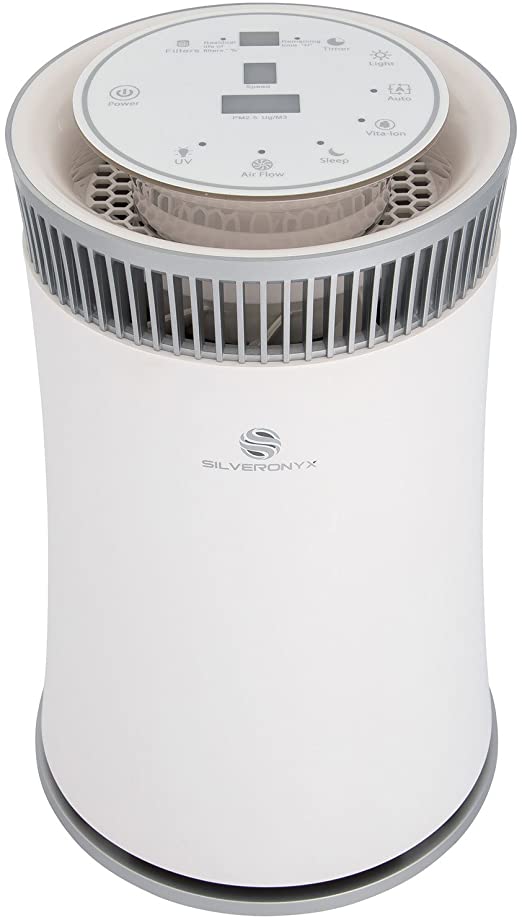
Best UV Air Purifier
SilverOnyx Air Purifier
- 5 power levels
- Includes HEPA filter and ionizer in addition to the UV filter
- Cleans rooms up to 500 square feet but only weighs 5 pounds
The SilverOnyx contains a UV sanitizer, but it also combines the power of a HEPA filter and ionizer. The UV-C light and sanitizer kills microorganisms like bacteria, mold, and viruses. However, to truly clean the air, it has a HEPA filter to trap airborne particles. In addition, an ionizer charges particles to become heavy and drop out of the air where they can be wiped or vacuumed away. You have the option of turning both the ionizer and the UV sanitizer on or off, depending on your needs.
At only five pounds, this air purifier is small enough to move from room to room if needed. The timer feature allows you to use the air purifier based on your schedule. It can run when you’re away from home or while you sleep.
A change filter indicator light takes out the guesswork of maintaining your air quality. When it turns on, you know it’s time for a replacement. Finally, we like that this purifier works as a nightlight. But you can turn the light off so it won’t disturb your sleep.
Tip: Air purifiers have filters that need to be washed and/or replaced regularly. Those with filter indicator lights automatically let you know when the filter is full, while those without requiring you to keep an eye on the filter. Most need to be replaced every six to eight months, but you may need to swap them out more often if your air quality is bad.
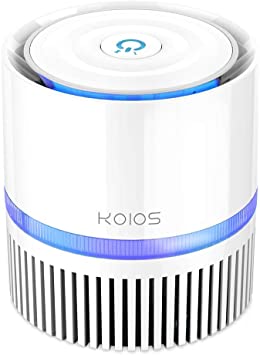
Best Portable Air Purifier
KOIOS Air Purifier
- Weighs 2.1 pounds
- Tiny dimensions — 7.5 x 6.9 x 6.9 inches — make it easy to hide anywhere in the room
- Neutralizes and captures allergens and odor
If you need a unit that’s inexpensive and can move with you from room to room, the KOIOS Air Purifier is the best portable air purifier for you. The KOIOS may be small at only 7.5 x 6.9 x 6.9 inches, but it’s powerful for its size, filtering 55 cubic feet of air in an hour.
Perfect for small spaces, this compact unit combines the power of HEPA and carbon filters. The HEPA filter takes care of particles as small as .3 microns while the carbon filter traps and neutralizes odors from wildfires, smoke, and cooking odors.
The noise level stays around 25 dB, which is comparable to rustling leaves. This isn’t an air purifier that is going to drown out your conversations. And it doubles as a nightlight. If you need the extra illumination, leave the light on. However, if it’s in the bedroom, there’s an off button for the light, so it won’t disturb your sleep.
The KOIOS traps all of the standard allergens like pet dander, pollen, and mold. The controls may be simple, but they’re perfect for a compact unit that can travel with you.
Tip: Pollutants build in unventilated/uncirculated air. Air purifiers filter the air when it’s not practical to open a window for natural ventilation. Portable models let you take that filtration power from room to room.
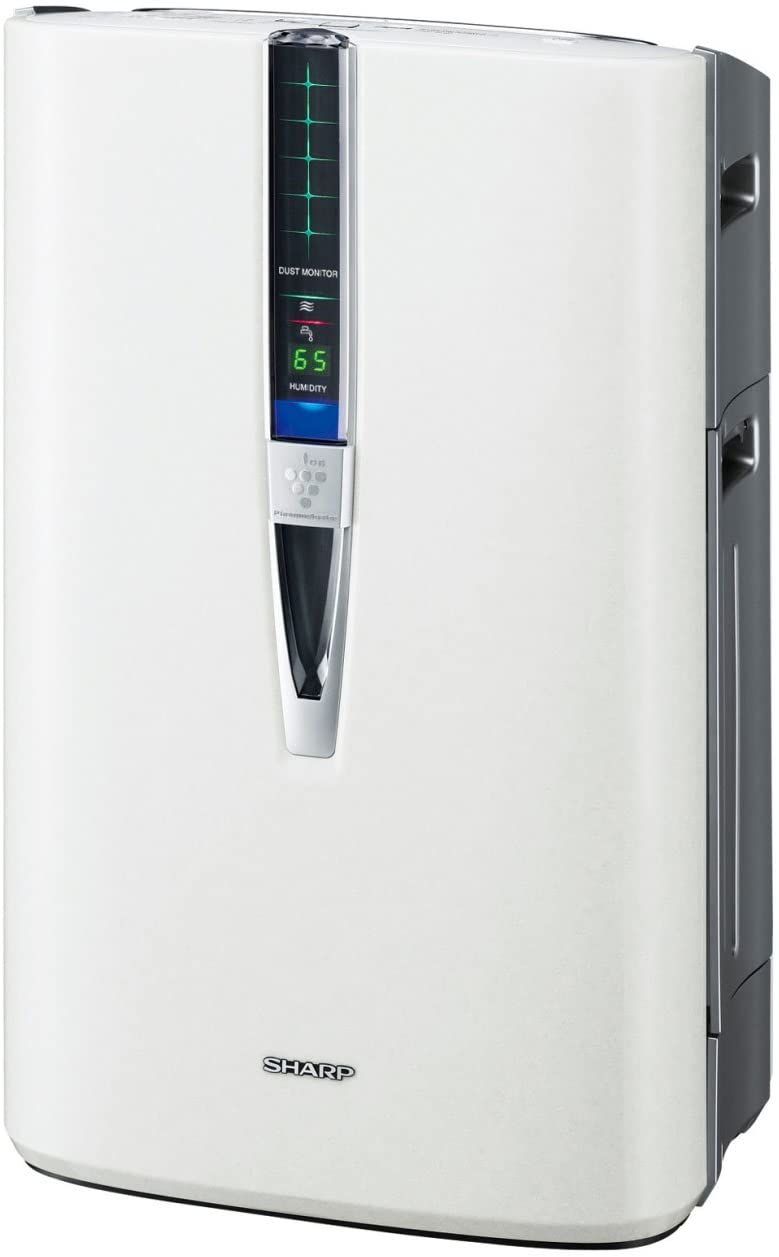
Best Humidifier/Air Purifier Combo
Sharp Plasmacluster Air Purifier
- 3 sensors, one each for dust, odor, and humidity
- Ion air purifier produces 5x less ozone than federal standards
- Designed for rooms up to 341 square feet
The Plasmacutter contains ion technology to purify as it humidifies. It produces charged ions that attach to the allergens and bacteria you want to get rid of. The goal is to remove the particles from the breathable space in your home.
The charge of the ions causes the particles to form clusters, weighing them down so that they settle rather than float through the air. As the particles fall, they’re pulled into the Plasmacutter’s HEPA filtration system, where they’re captured until they’re removed when the filter is replaced.
Charged particles can dry the air, which is why humidifier/purifier combos make sense. This type of air purifier is also helpful in arid climates, where you would need both a humidifier and an air purifier. The combo model cuts down on the cost and maintenance of appliances.
The Plasmacutter has automatic sensors that detect air quality and humidity levels so it knows when to turn on each feature. It includes a digital display so you can track the humidity levels in your home. If you don’t want to use the automatic settings, it has three fan speeds for manual adjustment.
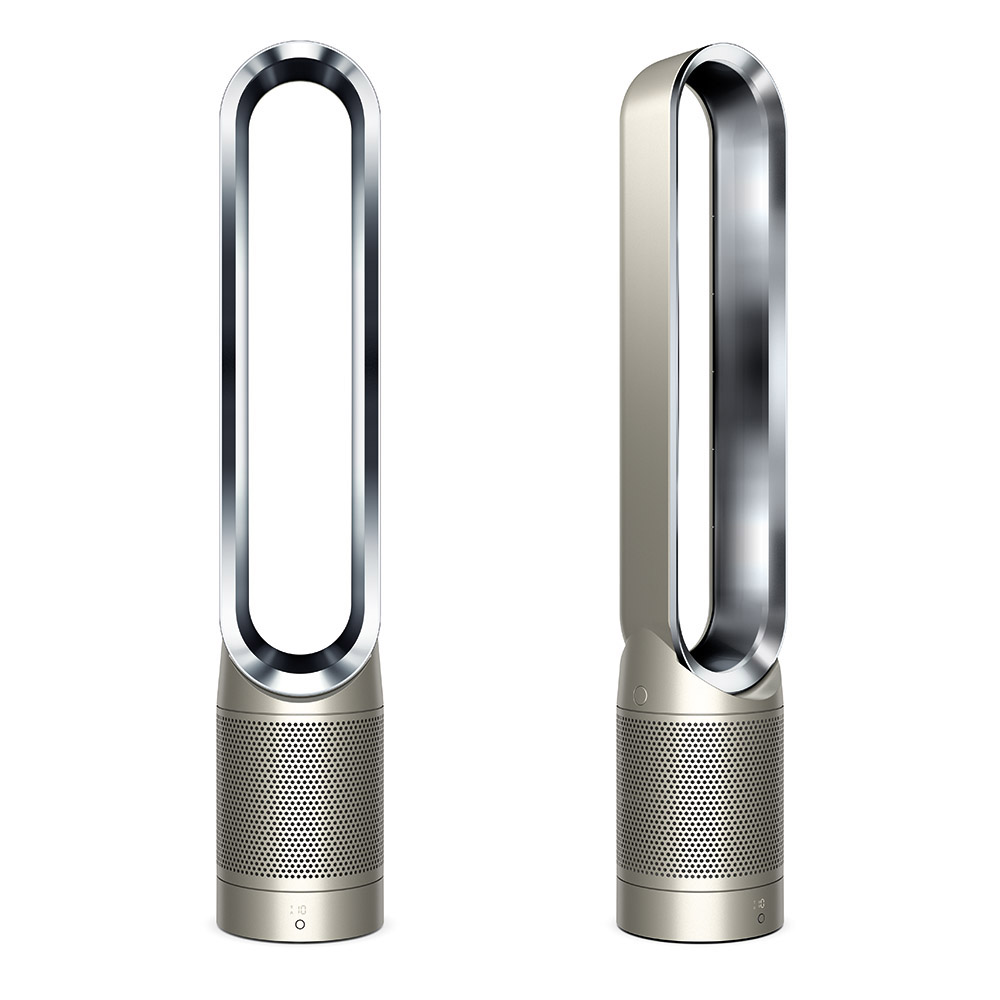
Best Smart Air Purifier
Dyson Pure Cool Link Tower TP02 Purifier Fan
- Acts as a purifier and a cooling fan
- HEPA filter targets allergens while carbon filter eliminates odors
- Offers auto safety features and 10 fan speeds
Dyson’s sleek designs are hard to pass by. This purifier/fan combo is a stylish and practical way to clean the air and cool your home. It utilizes a HEPA filter to remove particles, pollen, and allergens. However, it also incorporates a carbon filter to neutralize odors.
More importantly, it’s compatible with Alexa, so you can control it with your voice. It also links to the Dyson app, so you can monitor the room’s air quality and make adjustments to the purifier’s operations from anywhere.
This model gives you the ultimate in control features. There’s a quiet night time mode, a sleep timer, and ten airspeeds for the fan. If the Dyson gets knocked over, it automatically shuts off. For families with children and pets, it’s the perfect way to cool a room safely without fan blades.
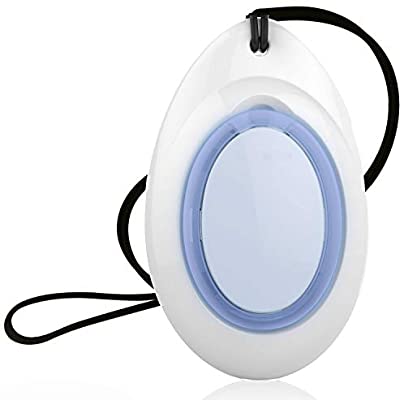
Best Wearable Air Purifier
Fey-US Wearable Air Purifier
- Ionic air purifier
- One button operation
- USB charger
The Fey-US Wearable Air Purifier allows you to bring ionic air purification anywhere. There’s a single control button that turns the purifier on and off, and that’s it. Simple control functions make this air purifier easy to use straight out of the package.
The ionic air purifier emits negatively charged ions that attach to particles near the purifier. When attached to viruses, fumes, pollen, and smoke particles, they increase the particles’ weight so they fall out of the breathing zone.
Wearable air purifiers like this model provide the ultimate in portability. You can wear it, hang it in your car, leave it on your nightstand, or take it with you on an airplane or car trip. Devices like this are perfect for people who are sensitive to odors, pollutants, and allergens or have respiratory problems.
Types of Air Purifiers
Air purifiers are divided into categories or types by their filtration system. Some filtration systems are specifically designed to target one type of pollutant like allergens, while others are designed to kill bacteria and viruses. Before buying, think about the kind of particles you need to remove from your indoor air. Those who live where wildfires are common or who experience dense air pollution have different needs than someone who only needs to remove allergens.
HEPA Technology
HEPA stands for High-Efficiency Particulate Air. To be called a HEPA filter, the filter must capture at least 99.97 percent of particles larger than .3 microns. That’s enough to trap bacteria, mold, viruses, and chemicals the naked eye can’t see. However, there are some smaller viruses and bacteria that HEPA filters may miss. HEPA technology does not have any harmful side effects, unlike some of the other filtration systems.
You may see some filters labeled “true HEPA” versus labels that read “HEPA-like.” HEPA-like filters aren’t actual HEPA filters and might not meet the full industry standard. The term “true HEPA” is meant to address these misleading labels. As long as the air purifier says “HEPA” or “true HEPA” filter, you’re getting the real thing. But if the label says “HEPA-like”, keep looking.
An air purifier with HEPA technology pulls the air through the filter several times per hour. The more often the purifier circulates air through the filter, the cleaner the air becomes. HEPA filters need to be cleaned or replaced when they become full. Depending on the quality of your air, that may be every six to eight months or every two to three months if you live in a high-pollutant area.
HEPA filters are incredibly efficient at trapping airborne particles, but they do have their limits. They cannot trap odors, gases, chemical fumes, or any airborne particles smaller than .3 microns, which means they don’t filter out bacteria, viruses, and the smallest of mold spores either. Many air purifiers with HEPA technology also have a carbon filter to absorb the odors and chemicals the HEPA filter misses.
(Activated) Carbon Filter or Charcoal Filter
Carbon filter air purifiers contain a filter made of activated carbon or charcoal, which is really just carbon. Activated carbon has thousands of microsized pores that absorb odors through chemical bonding. Carbon filters can capture smoke, gases, smog, and chemical emissions. They absorb harmful emissions like formaldehyde and benzene, both found in common furniture adhesives.
Asthma sufferers or individuals with multiple chemical sensitivity (MCS) greatly benefit from an air purifier with a carbon filter. However, they’re not as efficient at capturing airborne particles and allergens. For that reason, they’re almost always used in conjunction with a HEPA filter in top air purifiers.
Ionic
Of all the air purifiers, ionic models are the quietest because they can run without a motor. Ionic air purifiers, also known as an ionizer or ion generator, emit or create charged molecules called ions. The ions then attach themselves to particles in the air such as dust, pet dander, mold, and pollen. After attaching themselves to these particles, the ions are attracted to one another, creating larger, heavier clumps of molecules and particles. This causes the particles to settle, removing them from the breathable air zone.
Once the particles have fallen out of the breathable air zone, they often attach themselves to the floor, upholstery, carpet, and other surfaces, where they can be cleaned and removed. If the only type of filtration system the purifier has is an ionic system, it doesn’t actually filter the air. It only changes the weight of the particles so that they fall out of the air.
However, many ionic air purifiers also contain a second or even third filtration system to remove the air particles after they’ve attached to an ion. On the downside, an ionic air purifier with additional filtration systems will not be as quiet as a model that’s ion only.
Ultraviolet (UV)
Like an ionic purifier, a UV purifier usually includes another kind of particulate filtration system like HEPA or carbon. That’s because UV technology doesn’t filter particles, but rather kills microorganisms by breaking down their molecular bonds as they pass through the rays emitted by a UV bulb. They are effective for killing bacteria, mold, fungi, and viruses.
However, almost all air purifiers with UV technology include a second or third filtration system. That filtration should take place before the particles pass through the UV light. Otherwise, large particles can block the microorganisms from the UV light, allowing them to escape and re-enter the air.
If you opt for an air purifier with UV technology, read through the manufacturer’s instructions carefully. UV rays can create ozone and hydroxyl as they kill bacteria and neutralize odors. In fact, ozone is one of the factors that helps destroy odors, but it can be dangerous in high amounts, so look for a UV air purifier that allows you to turn the UV light on and off independently from the air purifier’s other filtration system(s). You don’t need to leave the UV light on 24/7. Most manufacturers offer a recommended running time for UV sanitation.
Generally, UV bulbs last at least a year, but they do need to be replaced. Check the price of replacement bulbs and factor that into the overall cost of the air purifier.
Air Purifier/Humidifier Combo
Air purifier/humidifier combos are a two-in-one solution for better air quality. We’ve already talked about how air purifiers remove common allergens, microorganisms, and other particles from the air. But in arid climates, dry air can contribute to coughs, colds, and sinus congestion. Air purifier/humidifier combos keep the air free of pollutants while adjusting humidity levels.
Alternative Combo Air Purifiers
Air purifiers often come with more than one type of filtration system. You may need an air purifier that has both a HEPA and carbon filter or a HEPA, carbon, and UV filtration system to neutralize odors, remove allergens, and kill pathogens. Most have more than one type of filtration system, so it’s a matter of finding the right combination for your unique situation.
Portable/Wearable Air Purifiers
Any air purifier that doesn’t connect directly to your home’s HVAC is technically considered a portable air purifier. However, some models are over 30 pounds and don’t have casters, so they’re not easy to move. We consider a portable air purifier to be one that’s less than 15 pounds. These small purifiers are easy to move from room to room, and some are small enough to pack on trips. After all, you need clean air when you’re on the road just as much as you do at home.
For those who are ultra-sensitive to pollutants and allergens, there are wearable or personal air purifiers. These purifiers hang from a necklace you wear around your neck. While these models aren’t as powerful as ones that clean a whole room, they’re worn close to the body so you’re always breathing clean air.
What do air purifiers filter and why?
Particulates of all kinds float through the air. Your body has natural defenses like nose hairs, sneezing, and mucous to keep harmful substances from entering your system. However, there are many potentially harmful particles small enough to sneak through and negatively impact your health.
Allergens
Pollen from flowers, trees, and grass trigger an immune response from people who are allergic to these substances. Watery, swollen eyes, nasal congestion, and generally feeling like you have a cold are common allergic reactions. Pet dander is another common allergen that’s invisible to the naked eye, yet it can be hidden on almost every surface of your home. You can keep allergies at bay with regular cleaning, but every time you vacuum or dust, a good portion of those particles get stirred up and reenter your breathable air.
Filters that capture particles up to .3 microns will typically rid the air of most allergens. Air purifiers may go about that process in a number of different ways, from HEPA filters to ionizers and carbon filters.
Chemical fumes, smog, smoke
These pollutants are most noticeable for their odors, but they can cause serious damage to the lungs and other body systems. The VOCs from the adhesives found in upholstery and flooring also fall into this category. Some are even found in bedding products.
Their particles are much smaller than .3 microns, which means they spread to almost every corner of your home. To take on these tiny particles, you need a carbon filter or ionizer because a HEPA filter alone won’t cut it.
Viruses and Bacteria
You come into contact with millions of organisms – including viruses and bacteria – throughout your day. Your body is able to defend itself from the vast majority of them. However, the very young, elderly, and people with compromised immune systems may need extra protection.
Some viruses and bacteria are over .3 microns and can be filtered with a HEPA filter, but those that are less than .2 microns will require either ionic filtration or UV technology.
Mold and Fungi
Out of control mold and fungi growth can easily cause breathing issues, whether you have an underlying condition or not. Most spores can be caught with the same types of filters that stop allergens. But some mold spores can be tiny, which means you may need an air purifier with ionic purification or a UV light.
Features to Consider When Shopping for the Best Air Purifier
Automatic Sensors
Air purifiers with automatic sensors turn on and off based on air quality levels. Models that also contain a humidifier may have sensors that also detect the air humidity. While this feature can be handy, air purifiers can be loud. If you have company coming over or are trying to watch television, you might want to use the manual controls so that the air purifier doesn’t turn on at an inopportune time.
Speed Settings
Almost all air cleaners have more than one fan speed. Lower settings and low speeds are quieter but don’t pull as much air through the purifier. High speeds, of course, clear the room faster but may be so loud that you only run it at night or when the air is particularly polluted. Some air purifiers have as many as ten speeds, but for good air quality, three is usually enough.
Control Isolation
Many air purifiers come with several stages of filtration and purification. While you want as much protection as you can possibly get, sometimes you may want to isolate the type of filtration you use. For example, you don’t want to leave a UV light on all day because it can release unhealthy amounts of ozone. Models with UV lights should have a control that allows you to turn off the UV feature while the other filtering functions continue.
The same can be said about models with a nightlight. Air purifiers are great additions to the bedroom, but if their lights shine like a beacon, they can interrupt your sleep cycle. Before you buy a model with a nightlight feature, make sure the light can be turned off independently of the air purifier’s other systems.
Smart Features/Wi-Fi
Smart air purifiers and those with Wi-Fi connectivity give you remote control over your air quality. You can check the air quality when you’re away from home, or schedule the purifier to turn on while you’re at work. The apps that go along with smart air purifiers may also create charts and graphs so you can identify patterns and changes in your indoor air quality.
Mobility
Air purifiers come in sizes that can clean an entire household. Some attach to your HVAC system too. However, these large units can be expensive and require professional installation. If you want to move the air purifier from room to room, you’ll need to think about mobility. Models with casters are easier to move. And before you think it’s silly to worry about moving an air purifier, models that can clean up to a thousand square feet or more may weigh as much as 25 to 30 pounds.
There are also air purifiers that weigh two to five pounds. They can’t clean a large space, but they’re easy to carry from room to room or take with you while you travel.
Indicator Lights
- Filter Change: Models with a filter change indicator take some of the guesswork out of the air purifier’s maintenance. Air purifiers become less effective as the filter fills. Therefore, it’s important to replace the filter regularly.
- Nightlights: Nightlights aren’t technically an indicator light. However, if you get a model with a nightlight, be sure there is a way to shut the light out so it doesn’t keep you awake at night.
- Air Quality: Models with air quality indicator lights let you know the current state of your indoor air. Most function on a color-coded system from green (clean) to red (poor air quality).
Warranty
Effective air purifiers should come with at least a one-year warranty, and some models come with up to a five-year warranty. Warranties typically cover the cost of labor and parts for any defect in manufacturing or professional installation.
Read through the owner’s manual to find out how to activate the warranty. Some products you’ll need to register, while for others you won’t need to contact the manufacturer unless you have a problem with their product.
Use and Environmental Considerations
There are factors about your home environment that need to be taken into consideration before buying an air purifier, including:
|
Air Purifier Filter Maintenance and Cleaning
Air filters, no matter the type, need to be cleaned or replaced regularly. Main filters and secondary filters are either disposable, washable, or permanent. Disposable filters cannot be washed or vacuumed so they should be thrown away once they’re full. Washable filters can usually be cleaned in a utility sink and dried before they’re placed back in the air purifier. Permanent filters should regularly be vacuumed to remove dust mites and debris, but they cannot get wet and should be replaced after a year.
Check the cost of replacement filters because they can be pricey. Models with washable or permanent filters that can be vacuumed will save money in the long run.
How often you need to replace the filter varies on a few factors, including:
- How frequently you run the air purifier.
- The quality of your indoor air.
- The quality of the water in which you wash the filter.
- The filter type since washable filters need to be replaced more often than a permanent filter, for example.
Best Practices
Air purifiers work better under the right conditions. To maximize its effects, be sure to:
- Close all windows and doors.
- Run the purifier regularly.
- Set filter cleaning and replacement reminders.
- Buy a unit that is large enough for the size of your room.
Frequently Asked Questions
Can an air purifier be too big for a room?
You really only need to worry about an air purifier being too small. If it’s too small, it won’t be able to circulate enough of the room’s air. However, a model that’s too big for a room may be bulky and take up more square space than you’d like. A large air purifier will clean the air faster than a small air purifier, so you can run it on a lower setting when in a small room.
Do air purifiers really make a difference?
Yes, they do, and unlike a filter, an air purifier removes and sanitizes air pollutants. However, they don’t remove everything as some particles embed in soft surfaces like upholstery, carpets, and curtains. And not every purifier will remove all pollutants. For example, an air purifier with a carbon filter or ionizer will get rid of smoke odors while a HEPA filter will not.
Where is the best place to put an air purifier in the room?
In an ideal situation, the air purifier would be in the center of the room away from any furniture or walls that disrupt airflow. However, air purifiers aren’t exactly a centerpiece, and they’d be easy to trip over. In the living room or kitchen, place the air purifier in a central yet out of the way location. Furniture and decor should not be too close so as not to disrupt air intake.
In the bedroom, place the air purifier along the wall at least six feet from the head of the bed but no more than ten feet. That puts it close enough that you breathe clean air but far enough away that the purifier doesn’t create a draft.
Final Advice
It doesn’t matter whether you have allergies or asthma; clean air is good for the mind and body. Efficient air purifiers with easy to use control features and the right filtration systems can protect your family by reducing exposure to harmful allergens and pollutants. It’s a matter of finding the right model for your specific needs, so you can buy the best air purifier for your bedroom, home, or even home office at the perfect price point too.


